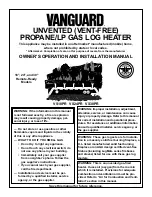
Installation and Operating Manual - SGW(S) Vulcan
© All rights reserved - Galmet Sp. z o.o. Sp. K.
4
pressure using a flow control valve. A safety valve, for example ZB8 FACH Cieszyn, must be installed on the cold water supply pipe, while the safety valve,
equipped with a function that reduces water pressure in the water heater through redirecting its flow back to the water supply installation, with a water
supply installation that, for a distance of 5 m from the sa fety valve, should withstand a water temperature of 90°C. The safety valve outlet must be constantly
open connected with the outside. It is permitted to connect the water heater in such a way as to draw water from a number of sources. The heating coil of the
water heater may be supplied from the low temperature water boiler, secured as per the standard PN 91/B 02413 working as part of an open system (p.13).
In order to protect pumps, the three way valve and the heat exchanger from pollution, a strainer filter should be installed in the circuit. It is
recommended to flush the entire heating system before installation. All connected branches must be thoroughly thermally insulated.
If the system will be working with domestic hot water heating as a priority using a three way valve, the installation instructions of the three way valve
manufacturer must always be respected. The temperature of the heating medium within the heating system must be lower than the switching temperature
of the temperature limiter (80°C). Once the water heater is installed and filled with wa ter, check the heater and installation for leaks. Only after filling the
water heater with water can the heating coil be connected to the electricity grid or the central heating system. In order to temporarily disable the water
heater, disconnect it from the electrical socket. If the water heater is disabled in winter and there is a concern that water may freeze inside the water, the
water heater should be drained by unscrewing the drain cap.
3. Troubleshooting
PROBLEM
CAUSE
METHOD OF ELIMINATION
The safety valve does not open
{even doing a blow through).
Safety valve seized.
Clean or replace the valve.
Safety valve leaks.
Touching surfaces of safety valve dirty or
defective.
Clean or scrub the touching surfaces of the safety valve.
Excessive water pressure in the network.
lnstal a flow control device.
Water from the water heater is dirty.
A large amount of sediment in the tank.
Clean the tank of sediment.
Worn out magnesium anode
Replace the magnesium anode - not covered by the warranty.
Uwaga!
1. At least once every 18 months replace the magnesium anode (keep the receipt for the magnesium anode). Regular replacement of the magnesium
anode is a requirement for maintaining a warranty on the tank (for an enamelled tank).
2. It is not allowed to install the water heater without a properly functioning safety valve.
3. The safety valve must be installed directly in front of the cold water pipe leading to the water heater. Only valves approved by the Technical Supervision
Office, designed for capacitive water heaters, can be used – ones with a return valve. The safety valve allows water to flow out of the heater, if an exces
sive increase in pressure in the heater occurs – opening pressure of 0.67 MPa.
4. No additional device can be installed between the safety valve and the water heater (e.g. shut off valve, water valve, etc.).
5. The repair method is specified by the manufacturer.
6. In the event of product defects importer. Free repairs of damage, for which the manufacturer is liable, will be remedied within 14 days from the date
of notification. THE WATER HEATER MUST NOT BE DISASSEMBLED. The receipt for the purchase of the water heater must be kept for after sales service
purposes. The number of repairs does not include gasket replacements, magnesium anode replace ments etc.
7. A properly filled out, complete and in no way corrected warranty card is the basis for having repairs done under warranty (it must be kept throughout
the warranty period).
8. Cases not covered by the above conditions are subject to the provisions of the Polish Civil Code.
9. Connections with the heaters must not be made of plastic pipes not designed to work at a temperature of 95°C and at a pressure of 0.7 MPa.
10. Water heaters must be installed in such a way as to ensure easy access (e.g. for maintenance, repair or replacement).
11. The manufacturer is not liable for any inconvenience or expense caused by the dismantling of addi tional housing elements.
12. In case water becomes odorous or darkly coloured, this is caused by the formation of hydrogen sulfide by sulfate reducing bacteria that live in oxygen
poor water. If cleaning the water heater, repla cing the magnesium anode and setting the temperature above 60°C do not improve the situation, we
recommend the use of a titanium anode connected separately to the power supply.
2. Installation / 3. Troubleshooting


































